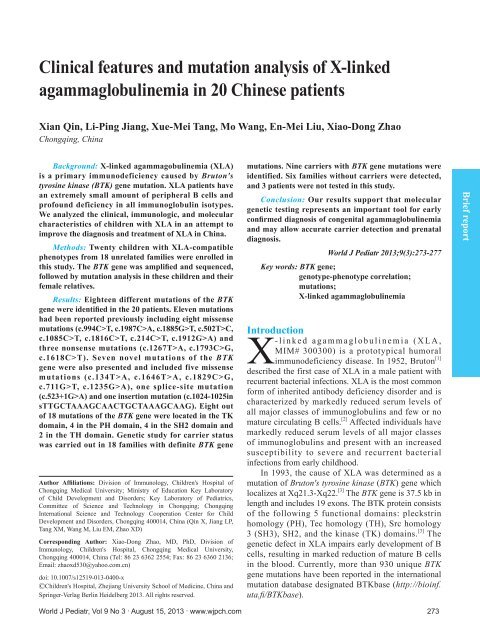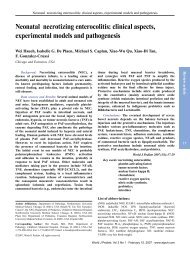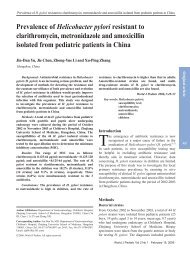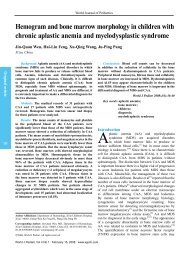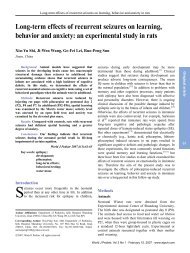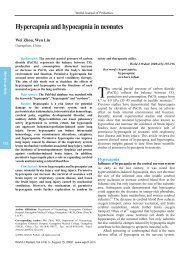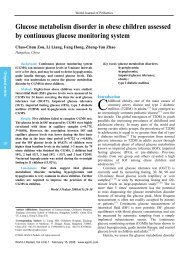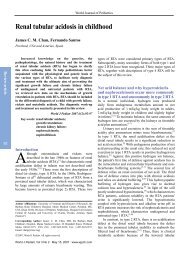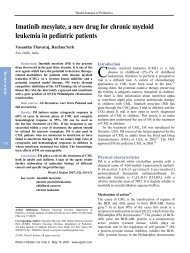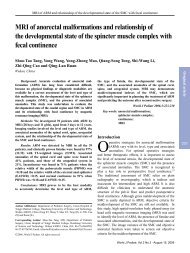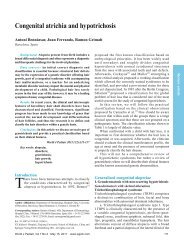Clinical features and mutation analysis of X-linked ...
Clinical features and mutation analysis of X-linked ...
Clinical features and mutation analysis of X-linked ...
You also want an ePaper? Increase the reach of your titles
YUMPU automatically turns print PDFs into web optimized ePapers that Google loves.
Mutation <strong>analysis</strong> <strong>of</strong> XLA in China<strong>Clinical</strong> <strong>features</strong> <strong>and</strong> <strong>mutation</strong> <strong>analysis</strong> <strong>of</strong> X-<strong>linked</strong>agammaglobulinemia in 20 Chinese patientsXian Qin, Li-Ping Jiang, Xue-Mei Tang, Mo Wang, En-Mei Liu, Xiao-Dong ZhaoChongqing, ChinaBackground: X-<strong>linked</strong> agammagobulinemia (XLA)is a primary immunodeficiency caused by Bruton'styrosine kinase (BTK) gene <strong>mutation</strong>. XLA patients havean extremely small amount <strong>of</strong> peripheral B cells <strong>and</strong>pr<strong>of</strong>ound deficiency in all immunoglobulin isotypes.We analyzed the clinical, immunologic, <strong>and</strong> molecularcharacteristics <strong>of</strong> children with XLA in an attempt toimprove the diagnosis <strong>and</strong> treatment <strong>of</strong> XLA in China.Methods: Twenty children with XLA-compatiblephenotypes from 18 unrelated families were enrolled inthis study. The BTK gene was amplified <strong>and</strong> sequenced,followed by <strong>mutation</strong> <strong>analysis</strong> in these children <strong>and</strong> theirfemale relatives.Results: Eighteen different <strong>mutation</strong>s <strong>of</strong> the BTKgene were identified in the 20 patients. Eleven <strong>mutation</strong>shad been reported previously including eight missense<strong>mutation</strong>s (c.994C>T, c.1987C>A, c.1885G>T, c.502T>C,c.1085C>T, c.1816C>T, c.214C>T, c.1912G>A) <strong>and</strong>three nonsense <strong>mutation</strong>s (c.1267T>A, c.1793C>G,c.1618C>T). Seven novel <strong>mutation</strong>s <strong>of</strong> the BTKgene were also presented <strong>and</strong> included five missense<strong>mutation</strong>s (c.134T>A, c.1646T>A, c.1829C>G,c.711G>T, c.1235G>A), one splice-site <strong>mutation</strong>(c.523+1G>A) <strong>and</strong> one insertion <strong>mutation</strong> (c.1024-1025insTTGCTAAAGCAACTGCTAAAGCAAG). Eight out<strong>of</strong> 18 <strong>mutation</strong>s <strong>of</strong> the BTK gene were located in the TKdomain, 4 in the PH domain, 4 in the SH2 domain <strong>and</strong>2 in the TH domain. Genetic study for carrier statuswas carried out in 18 families with definite BTK geneAuthor Affiliations: Division <strong>of</strong> Immunology, Children's Hospital <strong>of</strong>Chongqing Medical University; Ministry <strong>of</strong> Education Key Laboratory<strong>of</strong> Child Development <strong>and</strong> Disorders; Key Laboratory <strong>of</strong> Pediatrics,Committee <strong>of</strong> Science <strong>and</strong> Technology in Chongqing; ChongqingInternational Science <strong>and</strong> Technology Cooperation Center for ChildDevelopment <strong>and</strong> Disorders, Chongqing 400014, China (Qin X, Jiang LP,Tang XM, Wang M, Liu EM, Zhao XD)Corresponding Author: Xiao-Dong Zhao, MD, PhD, Division <strong>of</strong>Immunology, Children's Hospital, Chongqing Medical University,Chongqing 400014, China (Tel: 86 23 6362 2554; Fax: 86 23 6360 2136;Email: zhaoxd530@yahoo.com.cn)doi: 10.1007/s12519-013-0400-x©Children's Hospital, Zhejiang University School <strong>of</strong> Medicine, China <strong>and</strong>Springer-Verlag Berlin Heidelberg 2013. All rights reserved.<strong>mutation</strong>s. Nine carriers with BTK gene <strong>mutation</strong>s wereidentified. Six families without carriers were detected,<strong>and</strong> 3 patients were not tested in this study.Conclusion: Our results support that moleculargenetic testing represents an important tool for earlyconfirmed diagnosis <strong>of</strong> congenital agammaglobulinemia<strong>and</strong> may allow accurate carrier detection <strong>and</strong> prenataldiagnosis.World J Pediatr 2013;9(3):273-277Key words: BTK gene;genotype-phenotype correlation;<strong>mutation</strong>s;X-<strong>linked</strong> agammaglobulinemiaIntroductionX-<strong>linked</strong> agammaglobulinemia (XLA,MIM# 300300) is a prototypical humoralimmunodeficiency disease. In 1952, Bruton [1]described the first case <strong>of</strong> XLA in a male patient withrecurrent bacterial infections. XLA is the most commonform <strong>of</strong> inherited antibody deficiency disorder <strong>and</strong> ischaracterized by markedly reduced serum levels <strong>of</strong>all major classes <strong>of</strong> immunoglobulins <strong>and</strong> few or nomature circulating B cells. [2] Affected individuals havemarkedly reduced serum levels <strong>of</strong> all major classes<strong>of</strong> immunoglobulins <strong>and</strong> present with an increasedsusceptibility to severe <strong>and</strong> recurrent bacterialinfections from early childhood.In 1993, the cause <strong>of</strong> XLA was determined as a<strong>mutation</strong> <strong>of</strong> Bruton's tyrosine kinase (BTK) gene whichlocalizes at Xq21.3-Xq22. [3] The BTK gene is 37.5 kb inlength <strong>and</strong> includes 19 exons. The BTK protein consists<strong>of</strong> the following 5 functional domains: pleckstrinhomology (PH), Tec homology (TH), Src homology3 (SH3), SH2, <strong>and</strong> the kinase (TK) domains. [3] Thegenetic defect in XLA impairs early development <strong>of</strong> Bcells, resulting in marked reduction <strong>of</strong> mature B cellsin the blood. Currently, more than 930 unique BTKgene <strong>mutation</strong>s have been reported in the international<strong>mutation</strong> database designated BTKbase (http://bioinf.uta.fi/BTKbase).Brief reportWorld J Pediatr, Vol 9 No 3 . August 15, 2013 . www.wjpch.com273
Mutation <strong>analysis</strong> <strong>of</strong> XLA in Chinain two siblings, resulting in amino acid substitution<strong>of</strong> R28C at the PH domain. The R28 residue (codonCGC) is a common site <strong>of</strong> missense <strong>mutation</strong> in the PHdomain. In patient 15, another missense <strong>mutation</strong> ledto the substitution <strong>of</strong> R562W (codon CGG) in the TKdomain. The substitution <strong>of</strong> R288W in the SH2 domainwas detected in patient 3 in this study. R28C, R562W<strong>and</strong> R288W <strong>mutation</strong>s could cause structural defectsaffecting BTK function. However, not all <strong>mutation</strong>saffecting CpGs are likely to cause XLA. Only 8 <strong>of</strong> 18CpGs containing arginine codons were found to bemutated. [20] According to BTKbase, missense <strong>mutation</strong>at the TK domain is the most common <strong>mutation</strong> <strong>of</strong> theBTK gene <strong>and</strong> accounts for 59.6% among all missense<strong>mutation</strong>s in unrelated families.Molecular <strong>analysis</strong> <strong>of</strong> the BTK gene is a favorabletool for the diagnosis <strong>of</strong> XLA <strong>and</strong> for accurate carrierdetermination, which is essential for subsequentgenetic consulting. Attention to the "warning signs" <strong>of</strong>primary immunodeficiency, especially in the symptomfreeindividuals with a family history <strong>of</strong> the disease,is very important. Provision <strong>of</strong> genetic consulting <strong>and</strong>pre-symptomatic <strong>mutation</strong>al screening <strong>of</strong> members<strong>of</strong> affected families is essential to ensure earlydiagnosis <strong>and</strong> timely treatment. As the development<strong>of</strong> intravenous immunoglobulin, more patients surviveinto adulthood, <strong>and</strong> long-term complications includingbronchiectasis <strong>and</strong> malignancies should be followed up.Funding: This work was supported by a grant from ChongqingExcellent Young Scientists Fund (CSCT, 2008BA5040).Ethical approval: The study was approved by the EthicsCmmittee <strong>of</strong> Chongqing Medical University.Competing interest: There is no competing interest.Contributors: Qin X wrote the first draft under the supervision<strong>of</strong> Zhao XD. All authors contributed to the intellectual content<strong>and</strong> approved the final version. Zhao XD is the guarantor.References1 Bruton OC. Agammaglobulinemia. Pediatrics 1952;9:722-728.2 Nomura K, Kanegane H, Karasuyama H, Tsukada S, AgematsuK, Murakami G, et al. Genetic defect in human X-<strong>linked</strong>agammaglobulinemia impedes a maturational evolution <strong>of</strong> pro-Bcells into a later stage <strong>of</strong> pre-B cells in the B-cell differentiationpathway. Blood 2000;96:610-617.3 Vetrie D, Vorechovský I, Sideras P, Holl<strong>and</strong> J, Davies A, FlinterF, et al. The gene involved in X-<strong>linked</strong> agammaglobulinaemia isa member <strong>of</strong> the src family <strong>of</strong> protein-tyrosine kinases. Nature1993;361:226-233.4 Wang XC, Wang Y, Kanegane H, Toshio M, Yu YH. Genediagnosis <strong>of</strong> X-<strong>linked</strong> agammaglobulinemia. Zhonghua Er Ke ZaZhi 2005;43:449-452.5 Lee PP, Chen TX, Jiang LP, Chan KW, Yang W, Lee BW, et al.<strong>Clinical</strong> characteristics <strong>and</strong> genotype-phenotype correlation in62 patients with X-<strong>linked</strong> agammaglobulinemia. J Clin Immunol2010;30:121-131.6 Wang Y, Kanegane H, Wang X, Han X, Zhang Q, Zhao S, etal. Mutation <strong>of</strong> the BTK gene <strong>and</strong> clinical feature <strong>of</strong> X-<strong>linked</strong>agammaglobulinemia in mainl<strong>and</strong> China. J Clin Immunol2009;29:352-356.7 Conley ME, Notarangelo LD, Etzioni A. Diagnostic criteriafor primary immunodeficiencies. Representing PAGID (Pan-American Group for Immunodeficiency) <strong>and</strong> ESID (EuropeanSociety for Immunodeficiencies). Clin Immunol 1999;93:190-197.8 Brooimans RA, van den Berg AJ, Rijkers GT, S<strong>and</strong>ers LA, vanAmstel JK, Tilanus MG, et al. Identification <strong>of</strong> novel Bruton'styrosine kinase <strong>mutation</strong>s in 10 unrelated subjects with X <strong>linked</strong>agammaglobulinaemia. J Med Genet 1997;34:484-848.9 Vorechovský I, Vihinen M, de Saint Basile G, Honsová S,Hammarström L, Müller S, et al. DNA-based <strong>mutation</strong> <strong>analysis</strong><strong>of</strong> Bruton's tyrosine kinase gene in patients with X-<strong>linked</strong>agammaglobulinaemia. Hum Mol Genet 1995;4:51-58.10 Ochs HD, Notarangelo LD. X-<strong>linked</strong> immunodeficiencies. CurrAllergy Asthma Rep 2004;4:339-348.11 Conley ME, Howard V. <strong>Clinical</strong> findings leading to the diagnosis<strong>of</strong> X-<strong>linked</strong> agammaglobulinemia. J Pediatr 2002;141:566-571.12 Stewart DM, Lian L, Nelson DL. The clinical spectrum <strong>of</strong>Bruton's agammaglobulinemia. Curr Allergy Asthma Rep2001;1:558-565.13 Zhang ZY, Zhao XD, Jiang LP, Liu EM, Wang M, Yu J, et al.<strong>Clinical</strong> characteristics <strong>and</strong> molecular <strong>analysis</strong> <strong>of</strong> 21 Chinesechildren with congenital agammaglobulinemia. Sc<strong>and</strong> J Immunol2010;72:454-459.14 Conley ME, Mathias D, Treadaway J, Minegishi Y, RohrerJ. Mutations in btk in patients with presumed X-<strong>linked</strong>agammaglobulinemia. Am J Hum Genet 1998;62:1034-1043.15 Wicker LS, Scher I. X-<strong>linked</strong> immune deficiency (xid) <strong>of</strong> CBA/N mice. Curr Top Microbiol Immunol 1986;124:87-101.16 Rawlings DJ, Witte ON. Bruton's tyrosine kinase is a keyregulator in B-cell development. Immunol Rev 1994;138:105-119.17 Smith CI, Islam KB, Vorechovský I, Olerup O, Wallin E,Rabbani H, et al. X-<strong>linked</strong> agammaglobulinemia <strong>and</strong> otherimmunoglobulin deficiencies. Immunol Rev 1994;138:159-183.18 Kanegane H, Futatani T, Wang Y, Nomura K, Shinozaki K,Matsukura H, et al. <strong>Clinical</strong> <strong>and</strong> <strong>mutation</strong>al characteristics <strong>of</strong>X-<strong>linked</strong> agammaglobulinemia <strong>and</strong> its carrier identified by flowcytometric assessment combined with genetic <strong>analysis</strong>. J AllergyClin Immunol 2001;108:1012-1020.19 Holinski-Feder E, Weiss M, Br<strong>and</strong>au O, Jedele KB, Nore B,Bäckesjö CM, et al. Mutation screening <strong>of</strong> the BTK gene in56 families with X-<strong>linked</strong> agammaglobulinemia (XLA): 47unique<strong>mutation</strong>s without correlation to clinical course. Pediatrics1998;101:276-284.20 Lindvall JM, Blomberg KE, Väliaho J, Vargas L, Heinonen JE,Berglöf A, et al. Bruton's tyrosine kinase: cell biology, sequenceconservation, <strong>mutation</strong> spectrum, siRNA modifications, <strong>and</strong>expression pr<strong>of</strong>iling. Immunol Rev 2005;203:200-215.Received February 24, 2012Accepted after revision May 17, 2012Brief reportWorld J Pediatr, Vol 9 No 3 . August 15, 2013 . www.wjpch.com277


